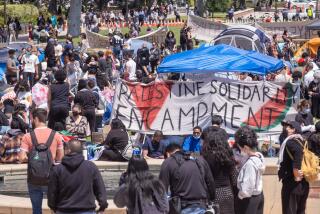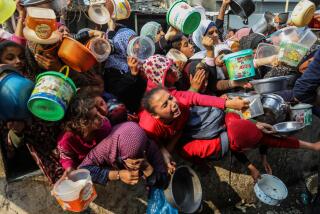Heavy metal uprising
True believers are essential to rock ‘n’ roll. That’s especially true in heavy metal, a sound fueled not just by raw aggression and noise, but by youthful feelings of frustration and rage, railing loudly against rules and authority. The greater the repression, the heavier the metal.
By that measure, any metal to emerge from the most restrictive regimes across the Middle East and North Africa should be the hardest rock of all, feeding off real poverty and oppression largely unknown to American rock fans. It is a landscape of war, dictatorship and uncertain democracy, where songs of horror and intolerance are reality-based, not fantasy. As one metalhead in Morocco told author Mark LeVine, “We play heavy metal because our lives are heavy metal.”
LeVine is one of the truest believers of all, a passionate adherent of Afrobeat visionary Fela Kuti’s declaration: “Music is the weapon of the future.” A professor of Middle Eastern history at UC Irvine and sometime musician, LeVine documents some vibrant, if marginalized, hard rock scenes across the region in “Heavy Metal Islam,” and comes away convinced of the “revolutionary potential of a bunch of kids.”
In chapters devoted to Morocco, Egypt, Lebanon, Iran, Pakistan and Israel and the Palestinian territories, LeVine hears an explosive cry for freedom he argues could have a role in resolving the communication breakdown between ethnic groups, sects, generations and classes. Whether that outsized hope is realistic or misplaced, the music he found during five years of travel represents a stirring alternative voice for Muslim youth.
He describes an environment where rapid globalization has shaken identity and community, places such as Morocco where the rich live more lavishly than ever and young multitudes from slums of Casablanca and elsewhere have few places to turn beside the local mosque. That gap, writes Le- Vine, is the “caldron that produces both Morocco’s metalheads and its extremists.”
Heavy metal musicians in the Islamic world are not typical careerists but musical revolutionaries putting everything at risk for little payoff beyond dreams of free expression. The price has been high, writes LeVine. Morocco initially repressed the scene, convicting 14 metal fans in 2003 as Satanists recruiting “for an international cult of devil worship.” In 1997, more than 100 players and fans were jailed in Egypt, where the grand mufti demanded they repent or be executed. (They were eventually released.) That same year in Iran, homes were raided and metal fans arrested.
Some struggles are internal. One young player from the Moroccan band Immortal Spirit was “wicked at soloing,” but quit the band and turned “fanatic about religion,” grew out his beard and no longer listens to music. The all-female Moroccan band Mystik Moods were screamed at by young men outraged by the idea of teenage girls playing metal. As one band member told LeVine, “It’s not easy to be a girl on the metal scene, no matter what country you’re living in.”
LeVine compares the polite, soft-spoken manner of Islamists he meets to conservative Christians back in the U.S. And the crackdown on “Marockan roll” and other scenes shares some of the historic intolerance for the devil’s music in America, where Beatles records were burned, shock-rockers arrested and songs banned from the airwaves. Young men in long hair and black T-shirts are proudly marginalized everywhere, but the stakes are far higher here.
In Egypt, where fans and musicians call themselves “metaliens,” LeVine found young women in head scarves banging their heads to the blunt death metal attack of Hate Suffocation. The scene represents a rare corner of that country’s society where religion is not central, and young bands are nurtured in garages, in basements, at private parties, while living freely and loudly online to be discovered by the rest of the world.
The book includes some striking scenes of politically charged hip-hop (the preferred musical language of Palestinian youth), but LeVine is most interested in loud guitars. His best chapter is on Iran, where there is no night life and women still can’t be shown singing on TV. Western pop culture is privately craved as the volunteer force of basij morality police patrol the streets and government agencies judge bands on such infractions as “too many riffs on electrical guitar and excessive stage movements.”
LeVine is not an especially vivid writer, and he tends to praise most of the music he presents, offering little critical context. But his material is rich, as he mingles scenes of conflict with surprising moments of understanding, such as the enthusiastic Arab following for the Israeli metal band Orphaned Land.
And while the sounds and scenes he finds are a fascinating social phenomenon, it’s not likely a movement to shake the rigid foundations of Iran or Pakistan, any more than Bruce Springsteen could get John Kerry elected president in 2004. Its value is as culture and communication, not geopolitics.
Metal is slowly being embraced in some corners of the region. By 2006, the Boulevard of Young Musicians fest in Casablanca enjoyed the support of the Ministry of Culture and increasing corporate sponsorship from Nokia.
But when the sounds of the underground reach stages in front of 20,000 paying fans it’s no longer just about outcasts and misfits. It has become a commercial enterprise, and any potential as political force will be left to the artists onstage to set free.
--
Steve Appleford is a journalist based in Los Angeles.
More to Read
The biggest entertainment stories
Get our big stories about Hollywood, film, television, music, arts, culture and more right in your inbox as soon as they publish.
You may occasionally receive promotional content from the Los Angeles Times.











